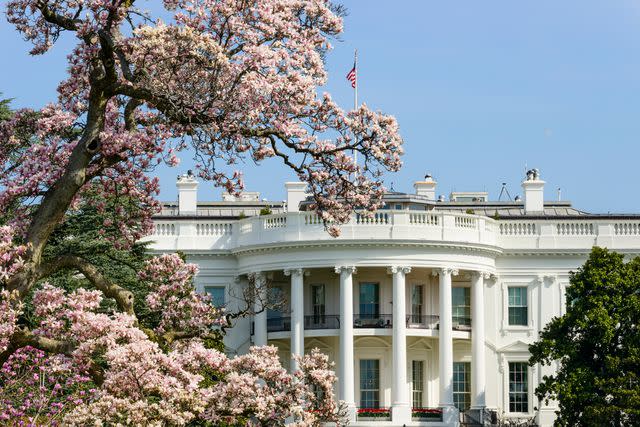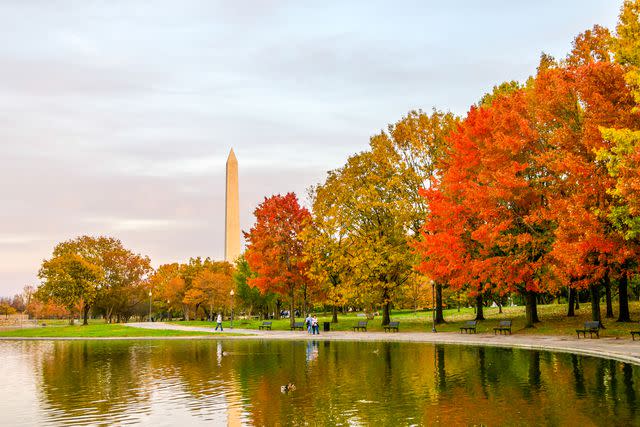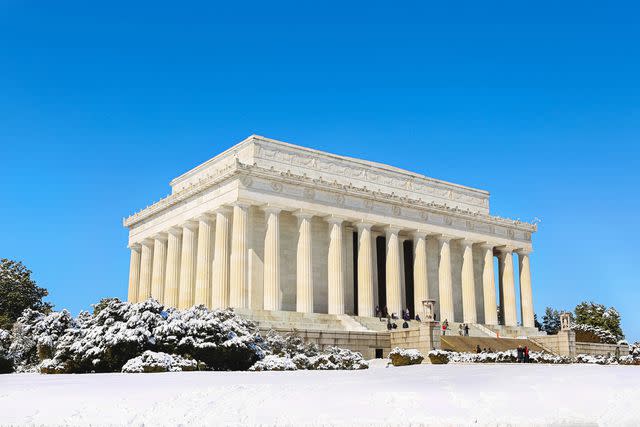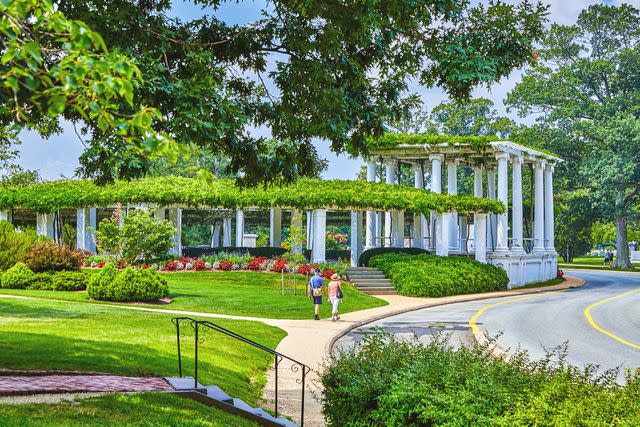The Best Times to Visit Washington, D.C., to See the Cherry Blossoms, Tour the National Mall, and More
These are the best times to visit D.C. for every type of traveler.
Washington, D.C., is always buzzing with activity — and we don't just mean politics. Whether you're a history enthusiast, an art aficionado, a foodie, or a fan of the outdoors, you'll find something to enjoy in our nation's capital at any time of the year.
While there's no bad time to visit, though, some are busier than others, and knowing which months offer the lightest crowds can help you make the most of your trip. To get you started, here's a rough breakdown of the city's tourist seasons.

OGphoto/Getty Images
High Season: Mid-March to July
Shoulder Season: September to December
Low Seasons: January to mid-March, plus the month of August
If you're thinking of a visit, check out this guide to the best times to travel to D.C. for activities such as museum-hopping, boat tours, and enjoying the spectacular cherry blossoms.
Related: T+L's Guide to Washington, D.C.

Matt Anderson/Getty Images
Best Times to Visit Washington, D.C., for Smaller Crowds
"Winter is a good time to visit if you want to avoid crowds," says Susan Sullivan Lagon, hotel historian at perennial Travel + Leisure reader favorite The Jefferson D.C. "The Smithsonian and most other museums are open, and locals like to visit around the holidays when fewer tourists are in town." In addition to museums, the capital's historic landmarks tend to be less crowded at this time of year, too. January, February, and the first half of March are all typically quiet, though there are exceptions to this rule. If you visit during one of the season's federal holidays, like Martin Luther King Jr. Day and Presidents' Day, or during a special event like a presidential inauguration, you can expect much larger crowds than you'd typically see in the winter.
If visiting during the colder months is not an option, consider planning your trip for a weekday. At almost any time of year, a midweek trip should be less crowded and less expensive than a weekend visit.
Best Times to Visit Washington, D.C., for Good Weather
Compared to much of the East Coast, Washington, D.C., has fairly mild winters. There's little snow, and, in most years, freezing temperatures are uncommon. For travelers from cold climates, then, a winter visit to D.C. can seem downright pleasant.
The best weather for sightseeing, though, comes in the spring and fall. According to Brian Salley, the chief concierge of the Waldorf Astoria Washington, D.C., though, April, May, and the period between late September and early November offer the best conditions of the year.
Keep in mind that if you come in early September, you'll likely get the hot and humid summer weather many Washingtonians try to avoid. However, the best thing about visiting D.C. is that even if the weather doesn't cooperate, you can always go into a gallery, a museum, or a hip shop to cool off, warm up, or wait out a storm.

Nora_Alhelal/Getty Images
Best Times to Visit Washington, D.C., for Lower Prices
While D.C. is not a cheap place to visit or travel to (Dulles International Airport was recently ranked the most expensive for domestic travel), flight and hotel prices do vary throughout the year.
"Generally, you may find lower prices during the winter months, particularly from January to early March when tourism is slower," says Salley. "Additionally, weekdays tend to have more affordable rates compared to weekends."
Thankfully, D.C. has accommodation and dining options for any budget. You can also search for more wallet-friendly lodging in Maryland and Virginia. Many border towns in these states are served by the Metro, which is the most convenient way to commute to D.C.
Best Times to Visit Washington, D.C., to See the Cherry Blossoms
In 1912, Japan gifted the American people sakura trees as a symbol of friendship. They were planted at the Tidal Basin in D.C., and the yearly celebration of their spectacular blooming is now known as the National Cherry Blossom Festival, which takes place over several weeks each spring.
"Mother Nature can be notoriously fickle, and it's impossible to time precisely when 'peak bloom' occurs around the Tidal Basin," says Lagon. "The window is between mid-March and mid-April." To help you pin down precisely the best dates for your trip, though, there are some useful resources. The National Park Service has a convenient "Bloom Watch" page on its website that tracks and forecasts the peak, and the National Cherry Blossom Festival website also monitors blooming progress as well as listing related events.
Whenever peak bloom does occur, you can count on massive crowds ringing the Tidal Basin in the hopes of getting a good view. To avoid them, Lagon recommends heading to Dumbarton Oaks Gardens in Georgetown, the Hains Point loop near the Wharf, or Stanton Park on Capitol Hill, all places with stunning cherry blossom trees.
Related: The Best Places to See Cherry Blossoms in Washington, D.C.
Best Times to Visit Washington, D.C., to Tour the National Mall
The National Mall stretches two miles from the Lincoln Memorial to the U.S. Capitol. Together with the Memorial Parks, it makes up a green space called "America's Front Yard" that encompasses more than 100 historic landmarks and monuments. The area is open to visitors 24/7, though if you'd like to visit the inside of Washington Monument, you'll have to do it between 9 a.m. and 5 p.m. Be sure to check out the monument's maintenance schedule while you plan, too, as the site (typically open seven days a week) closes for upkeep one day of each month.
"The best time to visit the National Mall is during the spring and fall seasons," says Adrian Renart, assistant director of services at The St. Regis Washington, D.C. That's when conditions will be best for strolling the Mall's significant outdoor expanse. Renart adds, though, that there is another good time. "While temperatures can become quite hot and humid, midweek during the summer months tends to have the fewest crowds."

Peter Unger/Getty Images
Best Times to Visit Washington, D.C.’s Museums
One of the highlights of any trip to D.C. is exploring its many museums. The Smithsonian's dozen-plus D.C. properties are especially visitor-friendly, thanks to free admission and an almost-always-open schedule. (December 25 is the only day when the Smithsonian museums don't open to the public.) However, remember that The National Museum of African American History and Culture and the recently renovated Air & Space Museum require you to book a timed entry pass in advance.
While you can get into the museums at any time, some seasons will be better than others. For instance, Renart says January and February are among the best times to visit "if you'd like to have fewer people blocking your view of Leonardo DaVinci's ‘Ginevra de' Benci’ at the National Gallery of Art." August can be another good month for museum-hopping, since it falls between summer field trip season and the cooler fall months that many grown-up visitors prefer.
Related: 15 Best Museums in Washington, D.C.
Worst Times to Visit Washington, D.C.
You're almost always guaranteed a good time in Washington, D.C. However, many locals will advise you to avoid the city in August, as it's too hot and humid (in fact, many Washingtonians head out to the beach or mountains then). "Congress is out of session, and a few businesses shut down for a week or two when business is slow," Renart says. An August visit can save you money, but if you plan one, be sure to build in lots of air-conditioned indoor activities and frequent water breaks.
Renart adds that you may also want to avoid times when citywide conventions or special events (such as marches, memorials, or protests) are going on. Happenings like these fill the streets, hotels, and restaurants of downtown D.C., making reservations more difficult to find.
For more Travel & Leisure news, make sure to sign up for our newsletter!
Read the original article on Travel & Leisure.

